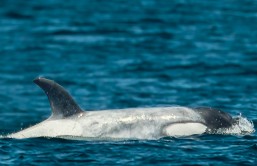Scientists looked at the genomes of the last wild horses on Earth to gain insight into the evolution of the fascinating animals. The world's last truly wild horses galloped along the steppes of Mongolia and China in the late 1800s, but by the 1960s only one small population of those horses remained and had likely been interbred with domestic hoses, Cell Press reported. Today, major conservation efforts have regrown the population of Przewalski's horses to more than 2,000 individuals.
A team of researchers sequenced the genomes of 11 Przewalski's horses as well as all of the founding lineages and five historical specimens dating back more than a century. The results of the DNA analysis were compared with the genomes of 28 domesticated horses.
"The novelty of our approach is to have not only surveyed the present-day genomic diversity of Przewalski's horses, but also to monitor their past genomic diversity, leveraging on museum specimens," said Ludovic Orlando of the University of Copenhagen's Natural History Museum of Denmark. "That way we could assess the genetic impact of more than 100 years of captivity in what used to be a critically endangered animal."
The new analysis could help solve the ongoing debate about the evolutionary relationship between wild and domestic horses. Ancestors of both the Przewalski's horses and domesticated horses remained connected by gene flow for a long time after their divergence 45,000 years ago. Horse populations are believed to have continued to assimilate even before human domestication began.
"As a matter of fact, we also show that very early in captivity - in the early 1900s - domestic horses contributed significantly to some lineages of the Przewalski's horse pedigree," Orlando said. "It implies that not all of the surviving Przewalski's lineages represent the gene pool of wild horses equally."
The scientists discovered the greatest genetic differences between domesticated and wild horses involved "metabolism, cardiac disorders, muscle contraction, reproduction, behavior, and signaling pathways." The researchers also noticed the century in captivity led to a dramatically lower genetic diversity in the Przewalski's horses. Despite these potentially problematic changes, the researchers noted the conservation efforts appear to be doing the horses some good.
"Even though Przewalski's horses went through an extreme demographic collapse, the population seems to recover, and is still genetically diverse," Orlando said. "There is, thus, hope for [other] endangered populations, fighting similar demographic issues."
The findings were published in a recent edition of the journal Current Biology.








